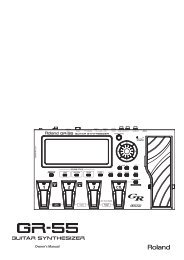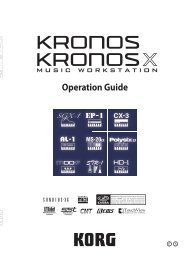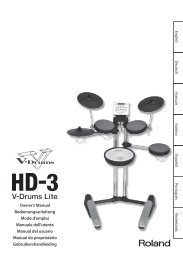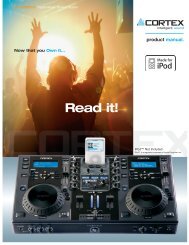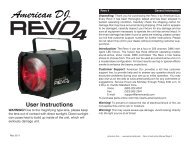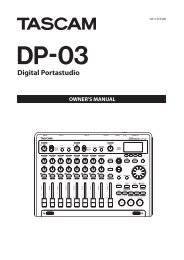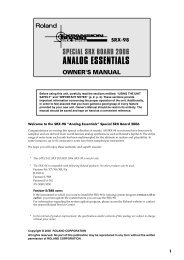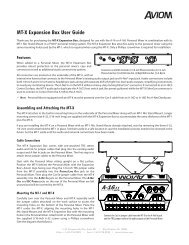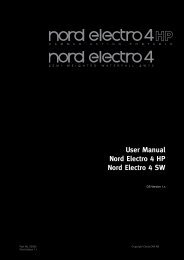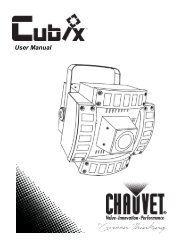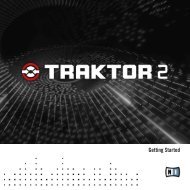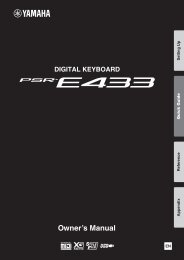Korg Microkorg Owner's Manual - zZounds.com
Korg Microkorg Owner's Manual - zZounds.com
Korg Microkorg Owner's Manual - zZounds.com
Create successful ePaper yourself
Turn your PDF publications into a flip-book with our unique Google optimized e-Paper software.
TAP<br />
EM-1<br />
1 2 3 4 5 7 8 9 10 11 12 13 14 15 16<br />
TAP<br />
EM-1<br />
1 2 3 4 5 7 8 9 10 11 12 13 14 15 16<br />
TAP<br />
EM-1<br />
1 2 3 4 5 7 8 9 10 11 12 13 14 15 16<br />
Using the microKORG with<br />
other MIDI devices (MIDI)<br />
○ ○ ○ ○ ○ ○ ○ ○ ○ ○ ○ ○ ○ ○ ○ ○ ○ ○ ○ ○ ○ ○ ○ ○ ○ ○ ○ ○ ○ ○ ○ ○ ○ ○ ○ ○ ○<br />
○<br />
Overview<br />
Here you can make MIDI-related settings for the microKORG.<br />
MIDI stands for Musical Instrument Digital Interface, and is a world-wide standard<br />
for exchanging various types of musical data between electronic musical instruments<br />
and <strong>com</strong>puters. When MIDI cables are used to connect two or more MIDI<br />
devices, performance data can be exchanged between the devices, even if they were<br />
made by different manufacturers.<br />
The microKORG lets you assign control change numbers to the major parameters<br />
that affect the sound, and control these parameters from an external MIDI sequencer<br />
while you play the tone generator. You can also operate the assigned knobs<br />
1–5 or keys to transmit these control changes to control an external MIDI device.<br />
You can synchronize the microKORG's arpeggiator, LFO rate, or the delay time of<br />
the delay effect to the MIDI Clock of an external MIDI sequencer.<br />
MIDI on the microKORG<br />
Controlling the microKORG's tone generator from an external<br />
MIDI device<br />
When you wish to play or control the microKORG's tone generator from an external<br />
MIDI keyboard or sequencer etc., use a MIDI cable to connect the MIDI OUT<br />
connector of the external MIDI device to the MIDI IN connector of the microKORG.<br />
microKORG<br />
MIDI IN<br />
MIDI OUT<br />
MIDI keyboard<br />
Controlling two or more external MIDI tone generators from the<br />
microKORG<br />
You can use the MIDI THRU connector to simultaneously control multiple MIDI<br />
devices. (This type of connection should be used to connect no more than three<br />
devices. If you wish to connect a larger number of MIDI devices, we re<strong>com</strong>mend<br />
that you use a MIDI patch bay as shown in the second diagram below.)<br />
○ ○ ○ ○ ○ ○ ○ ○ ○ ○ ○ ○ ○ ○ ○ ○ ○ ○ ○ ○ ○ ○ ○ ○ ○ ○ ○ ○ ○ ○ ○ ○ ○ ○ ○ ○ ○<br />
○<br />
Connecting MIDI devices/<strong>com</strong>puters<br />
microKORG<br />
MIDI OUT MIDI IN MIDI THRU<br />
MIDI IN<br />
Controlling an external MIDI tone generator from the microKORG<br />
When you wish to use the microKORG's keyboard, controllers, and arpeggiator etc.<br />
to play an external MIDI tone generator, use a MIDI cable to connect the<br />
microKORG's MIDI OUT connector to the MIDI IN connector of the external MIDI<br />
tone generator.<br />
MIDI keyboard<br />
MIDI tone generator<br />
You can also use a MIDI patch bay to control multiple MIDI devices.<br />
microKORG<br />
MIDI OUT<br />
MIDI IN<br />
MIDI OUT<br />
MIDI IN<br />
microKORG<br />
MIDI OUT<br />
MIDI IN<br />
MIDI patch bay<br />
MIDI OUT<br />
MIDI IN<br />
MIDI keyboard<br />
MIDI tone generator<br />
MIDI tone generator<br />
48



